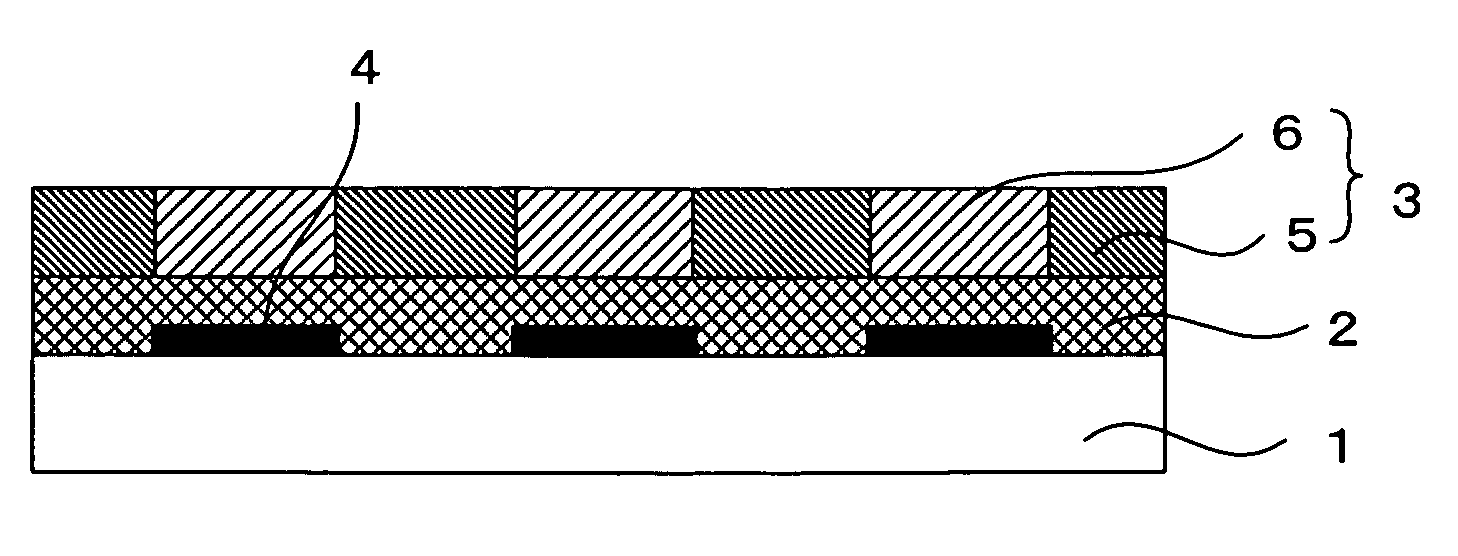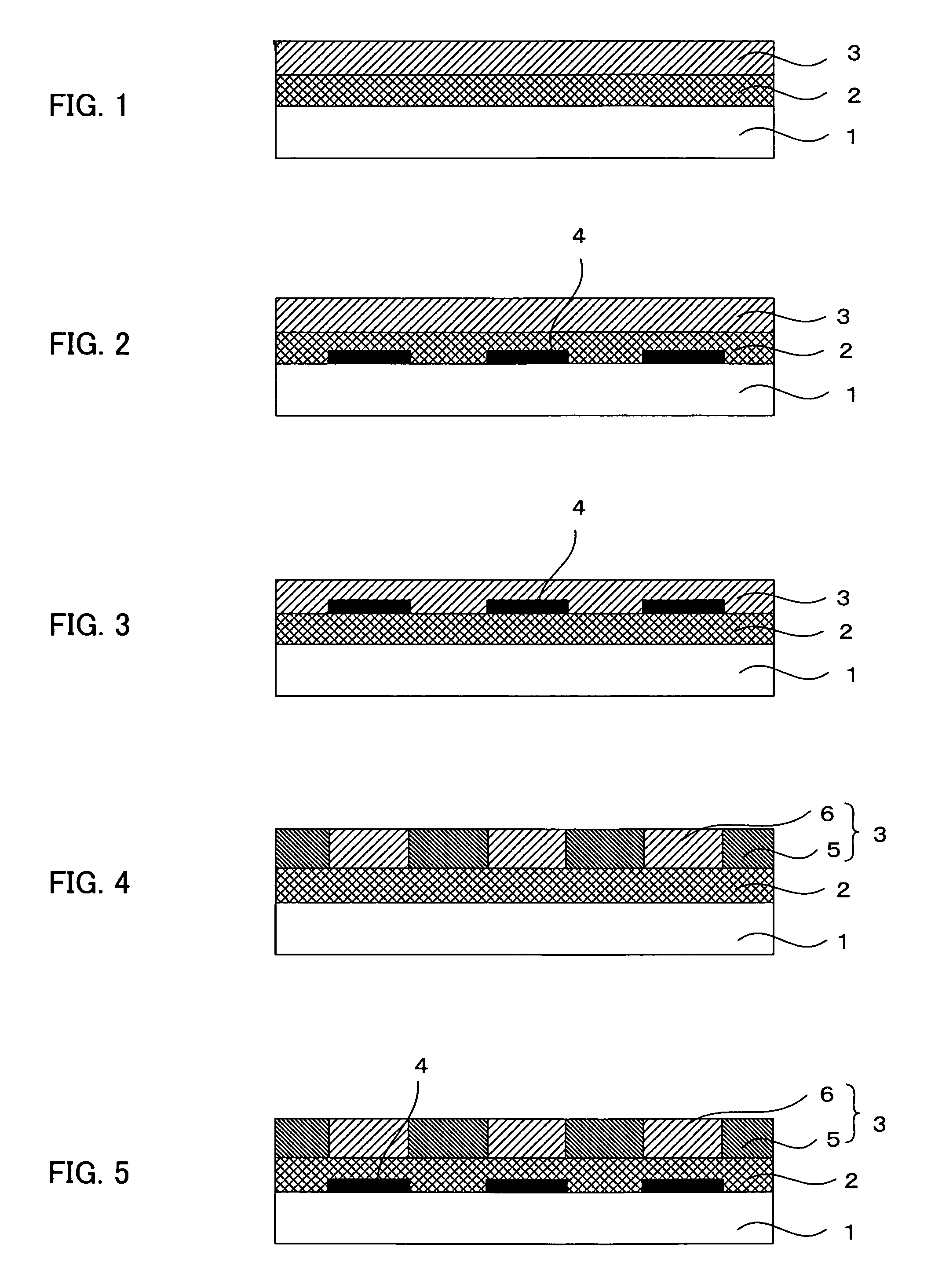Patterning substrate and cell culture substrate
a cell culture substrate and patterning technology, applied in biomass after-treatment, specific use bioreactors/fermenters, biochemistry apparatus and processes, etc., can solve the problems of inability to survive for a long period under flotation conditions out of organisms, narrow selectivity of cell adhesive materials, and affect the culturing of cells in some cases. , to achieve the effect of improving cell adhesive properties, preventing adhesion, and low cell adhesive properties
- Summary
- Abstract
- Description
- Claims
- Application Information
AI Technical Summary
Benefits of technology
Problems solved by technology
Method used
Image
Examples
example 1
(Formation of a Photocatalyst-containing Layer)
[0162] Three grams of isopropyl alcohol, 0.4 g of an organosilane, TSL 8114 (manufactured by GE Toshiba Silicones), and 1.5 g of a photocatalyst inorganic coating agent, ST-K01 (manufactured by ISHIHARA SANGYO KAISYA, LTD.) were mixed, and then the mixture was heated at 100° C. for 20 minutes while stirred.
[0163] This solution was applied onto a glass substrate subjected to alkali treatment in advance by spin coating method, and the substrate was dried at 150° C. for 10 minutes to advance hydrolysis and polycondensation reaction, thereby forming, on the substrate, a photocatalyst-containing layer, 0.2 μm in thickness, wherein the photocatalyst was strongly fixed into an organopolysiloxane.
(Formation of a Cell Adhesion-inhibiting Layer)
[0164] A solution of 5 g of isopropyl alcohol, 0.4 g of an organosilane, TSL8114 (manufactured by GE Toshiba Silicones), and 0.04 g of a fluoroalkylsilane, TSL8233 (manufactured by GE Toshiba Silicone...
example 2
(Formation of a Cell Culture Patterning Substrate)
[0171] A quartz substrate, wherein a stripe-form shielding layer having light-shielding portions of 80 μm width and space portions of 300 μm width was formed on a surface of a base material, was prepared. A photocatalyst-containing layer and a cell adhesion-inhibiting layer were formed on the surface of this substrate with the shielding layer in the same way as in Example 1. Next, instead of using any photomask, ultraviolet rays were irradiated onto the entire back face of the substrate from the back face side of the substrate under the same conditions as in Example 1 to form a cell culture patterning substrate.
[0172] Cells were caused to adhere onto the above-mentioned patterning substrate in the same way as in Example 1. As a result, in this substrate also, it was found out that the cells adhered along the cell adhesion portions of the cell culture patterning substrate.
example 3
[0173] A hole of 14 mm diameter was made at the center of the bottom face of a commercially available plastic dish (manufactured by Corning Inc.) of 35mm diameter. Subsequently, a glass substrate of about 0.1 mm thickness was used to form a cell culture patterning substrate in the same way as in Example 1. This cell culture patterning substrate was cut into a 21 mm square. Thereafter, the glass substrate of the cut cell culture patterning substrate was stuck onto the above-mentioned plastic dish through an adhesive agent, KE45T (Shin-Etsu Chemical Co., Ltd).
[0174] The plastic dish was sterilized with 70% ethanol, and washed with PBS. Thereafter, the dish was washed with a DMEM culture medium. Cells were then cultured in the same way as in Example 1. As a result, it was found out that the cells adhered along the cell adhesion portions in the plastic dish.
PUM
| Property | Measurement | Unit |
|---|---|---|
| mole ratio | aaaaa | aaaaa |
| contact angle | aaaaa | aaaaa |
| contact angle | aaaaa | aaaaa |
Abstract
Description
Claims
Application Information
 Login to View More
Login to View More - R&D
- Intellectual Property
- Life Sciences
- Materials
- Tech Scout
- Unparalleled Data Quality
- Higher Quality Content
- 60% Fewer Hallucinations
Browse by: Latest US Patents, China's latest patents, Technical Efficacy Thesaurus, Application Domain, Technology Topic, Popular Technical Reports.
© 2025 PatSnap. All rights reserved.Legal|Privacy policy|Modern Slavery Act Transparency Statement|Sitemap|About US| Contact US: help@patsnap.com



